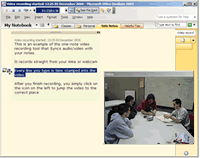 Microsoft Onenote is an odd beast. It has some potentially great features that don’t seem to be properly executed yet. One of these features is the way it allows you to record audio or video (e.g. via a mike or webcam) and take notes simultaneously (as pictured). Then, after the recording, you can click on any line of your notes and have the audio/video jump to that point. (All it does is it time-stamp each line you type and associate it with the recording – quite simple really). This is amazingly useful for live transcription while recording interviews, podcasts, lectures, minute taking in meetings, and most importantly in my line of work, taking notes in usability tests & focus groups.
Microsoft Onenote is an odd beast. It has some potentially great features that don’t seem to be properly executed yet. One of these features is the way it allows you to record audio or video (e.g. via a mike or webcam) and take notes simultaneously (as pictured). Then, after the recording, you can click on any line of your notes and have the audio/video jump to that point. (All it does is it time-stamp each line you type and associate it with the recording – quite simple really). This is amazingly useful for live transcription while recording interviews, podcasts, lectures, minute taking in meetings, and most importantly in my line of work, taking notes in usability tests & focus groups.
For example, the average user testing project generates about 18 hours of video. You can’t give it all to your client and expect them to trawl through it – you have to give them some way of getting to the good bits quickly.
It seems like a no-brainer to me that a tool like Onenote could easily offer a one-click export function for stand-alone video or audio file with chapter markers, a series of files segmented on the basis of the timestamps, or even an Enhanced Podcast as Guy Kewney suggests in his recent article in The Register.
As well as Onenote, Morae, VisualMark and Noldus all kind of offer this functionality, but none of them do it properly – yet.
What do you mean by “none of them do it properly – yet”? It would be useful to know, in some detail, what you consider properly.
You’re right, I was being a bit vague there. I hasten to add that I am actually Morae’s biggest fan and I’m always singing its praises :-)
Basically, my issue with Morae is that you can’t take “free text” notes and have them associated with the timeline automatically every time you reach a new line. Morae supposes that you have predefined your markers, i.e. the type of issue your users are going to experience before the session. The way I work is that I define the types of issue after running all the sessions, not before. And the type of issue is very specific to the project in hand.
The way we currently get around this is to take observational notes in MS Word, and insert a timestamp (using a macro) whenever anything interesting happens. After the study we then go back into Morae Manager and do a search for the RRT entry for that time (recorded because the time is displayed in the system tray).
The style of notes we take is basically a transcript of what’s said and done, loosely combined with the observer’s interpretations and thoughts. Whenever something particularly interesting happens, the observer usually types a string of ************s, the number of stars roughly representing the level of importance. This is how we find appropriate segments for the highlight videos. I should add that the majority of user studies we do are qualitative. There’s not much point in getting carried away with numbers if you’ve only got a dozen users.
Pingback: Open-Source Video Note Taking Utility from IBM- 90 Percent of Everything